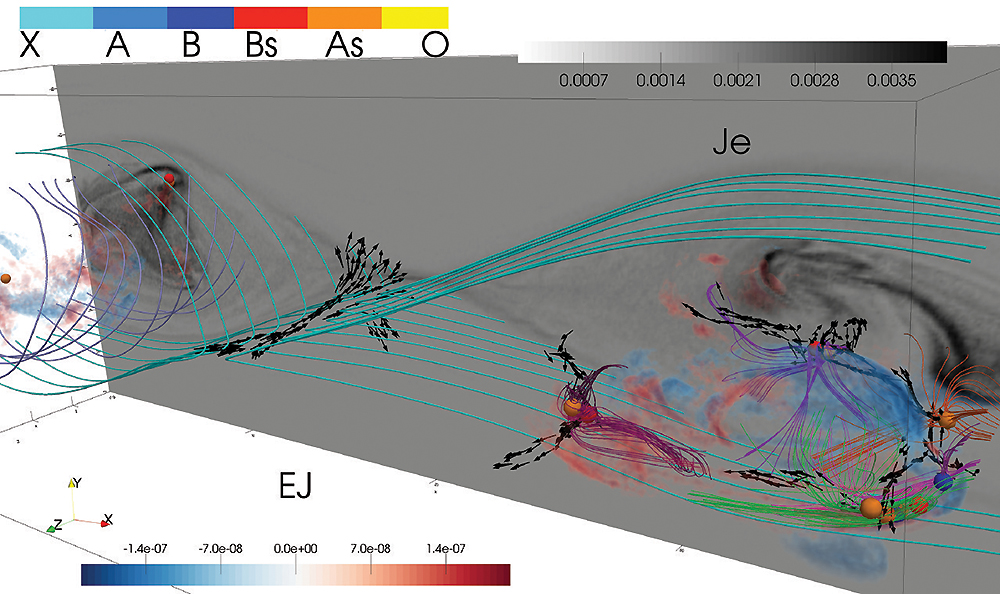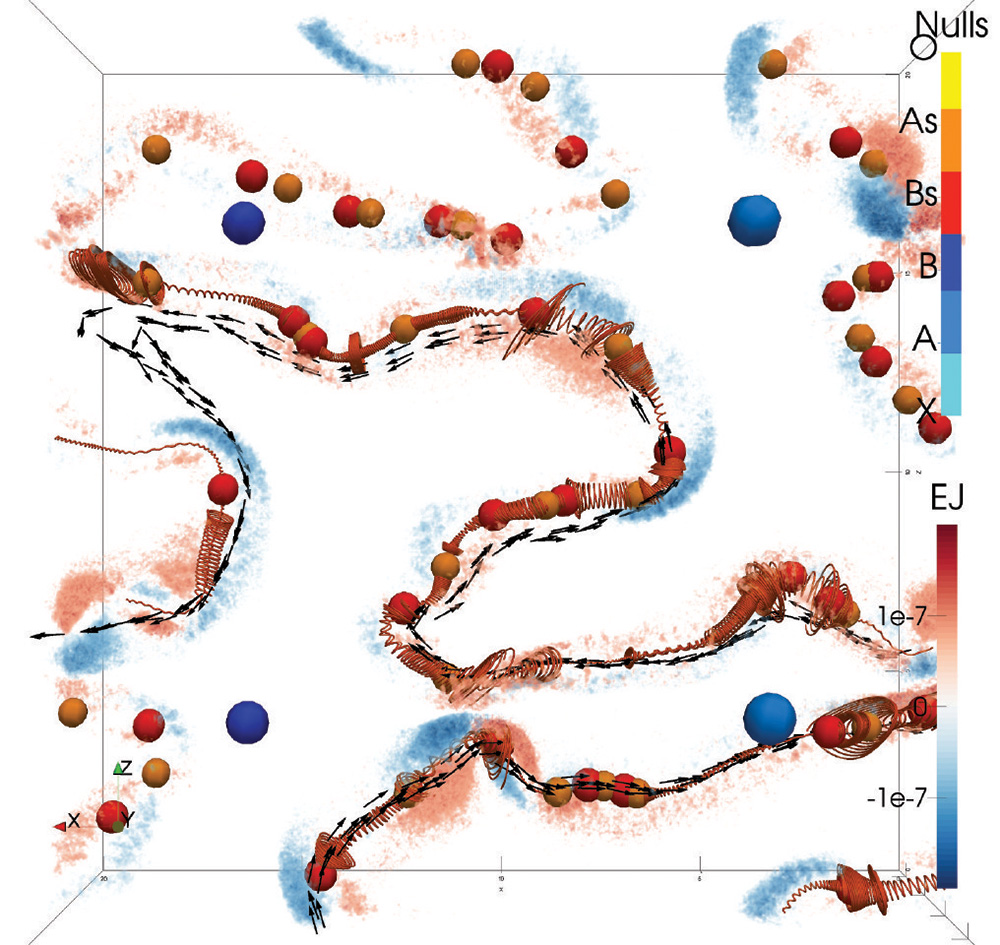ASTROPHYSICS
Magnetic Reconnection in 3D
Principal Investigator:
Giovanni Lapenta
Affiliation:
KU Leuven (Belgium)
Local Project ID:
pr87di
HPC Platform used:
SuperMUC of LRZ
Date published:
The process of magnetic reconnection — when magnetic fields in plasma reconfigure and explosively release thermal and kinetic energy — is only just beginning to be understood. Professor Giovanni Lapenta has been carrying out simulations on SuperMUC of how these events can cause chain reactions that very quickly fill vast volumes of space. This data is now being verified with the recent NASA Magnetospheric MultiScale Mission that is measuring magnetic reconnection events around the Earth.
Magnetic reconnection is one of the most striking processes in the universe. It happens when hot charged gases, called plasma, reconfigure their magnetic field lines. This releases a formidable amount of energy as the magnetic field is converted into heat and kinetic energy, accelerating particles up to close to the speed of light.
The process is thought to be the main way in which magnetic field energy can be released into particles. It happens in a number of astrophysical settings such as on the surface of stars and in jets produced around black holes, but can also occur in laboratory settings. For example, tokamaks — torus (think hollow doughnut) shaped devices designed to confine plasma for fusion reactions — can experience disruption events in which huge (and undesirable) releases of energy can be deposited on the walls of the machine, causing damage. Methods for using magnetic reconnection constructively in order to provide propulsion for long-distance space missions are also being investigated.

Figure 1: Magnetic null points are the preferred locations for magnetic reconnection, a process of explosive energy release responsible for solar ares and aurorae. Magnetic nulls are in the focus of many space missions such as Cluster and MMS. Kinetic particle-in-cell (PIC) simulations are the primary tools for studying magnetic reconnection in space plasmas. We detect and classify nulls in various 3D kinetic PIC simulations. We analyse simulations of different regions of space: solar wind and magnetosphere, magnetosheath, magnetotail, and even lunar surface.
Copyright: KU Leuven, BelgiumThe tremendous amounts of energy that are suddenly and explosively released in this way are a topic of great interest for physicists. Professor Giovanni Lapenta of KU Leuven in Belgium has been investigating how these events happen and especially how they occur in such large volumes. “There are a lot of models that explain magnetic reconnection on a microscopic level, where energy is released quickly but in small amounts,” he says. “But to understand how a much larger amount of energy is released so quickly is more of a challenge.”
Large-scale examples of reconnection, known as turbulent reconnection, are seen commonly in solar physics. Areas of the sun can be observed storing up energy, becoming more and more energetic until the energy is released in the form of a solar flare, or in more extreme cases in an event called coronal mass ejection. These ejections can cause shockwaves and particles that, if they reach the Earth, create geomagnetic storms that can disrupt radio transmissions and damage satellites. These solar energetic particles also cause particularly strong instances of aurora around the Earth’s poles and damage transmission and power lines on the ground.
Similar events can occur in the accretion disks of material that orbit around black holes. Energy is released in jets that can be thousands of light years long, emitting electromagnetic radiation across the spectrum. “These jets constantly replenish themselves, all along the jet, so there must be a source of energy fuelling them that is not just found in the black hole,” says Lapenta. Up until recently, scientists had struggled to understand how this process occurs, but Lapenta and his colleagues now think they have a more comprehensive explanation for what is occurring.

Figure 2: The statistics of the null point topological types is well in accordance with spacecraft observations. Energy dissipation happens in magnetic flux ropes with spiral nulls inside. These flux ropes dissipate magnetic energy due to secondary instabilities. Images above illustrate the results of our simulations. The null points are marked with color spheres, color represents the topological type of the null. Also shown are magnetic field lines and energy dissipation measure, red and blue fog. In some images, additional plasma characteristics are shown and marked.
Copyright: KU Leuven, BelgiumBy carrying out large-scale simulations on supercomputers, Lapenta and his fellow researchers have concluded that magnetic reconnection events can cause chain reactions that set off subsequent reconnection events. “In our simulations, reconnection begins at one point in space at which magnetic energy starts to be released. This creates a turbulent flow that expands out of the region and causes new reconnection events to take place, progressively feeding bigger and bigger regions in a cascade that can very quickly convert huge amounts of energy.
“It’s really quite an amazing spectacle,” says Lapenta. “People had drawn up sketches of how they thought this happens, but what we have done is to prove this in practice through simulations. To do this properly, we needed to simulate large amounts of energy in a 3D space with dimensions in the regions of millions of kilometres, all at a sufficient resolution to be able to observe the tiny regions in which the original reconnection events occur. To do this, we needed a lot of computing power!” 25 million core hours on the SuperMUC computer hosted by GCS at LRZ, Germany, were awarded for the project.
Given that the general proof for chain reactions of magnetic reconnection now exists, a number of new lines of investigation can now be explored. “We have the model, so now we need to make predictions from this model that are experimentally verifiable,” explains Lapenta. “For example, there is a current mission from NASA called the Magnetospheric MultiScale (MMS) mission which is measuring the distribution of electrons and ions around the Earth. It will be interesting to see how the observations made on this mission compare with our simulations. Will we be able to predict the distribution? Will we be able to see a difference between original points of reconnection and the subsequent ones generated by the chain reaction?”
When magnetic reconnection events occur, waves are created in the manner of an explosion. Lapenta is interested in what the MMS mission can find out about these waves. “These waves, as well as the high energy particles, also transfer energy from the magnetic reconnection process. What we want to see is how much energy is converted into the particles and how much is converted into these waves that are propagated out? This is the first time we have been able to directly measure these. Currently we are measuring waves characteristic of the secondary reconnection sites from the chain reaction, and trying to link what is seen with the simulations we have done.”
Another satellite mission will be launched to go very close to the sun and observe the effects of magnetic reconnection in the sun. Much of the work done in these simulations was done in preparation for this mission, so it won’t be long before the results of these simulations can be verified with real observations from around the solar system.
Acknowledgments:
This project was made possible through PRACE (Partnership for Advanced Computing in Europe) with HPC system SuperMUC of the Leibniz Supercomputing Centre at Garching near Munich (LRZ) serving as computing platform.
This is a reprint of the article published in the PRACE Annual Report 2015.
Scientific Contact:
Giovanni Lapenta
KU Leuven, Department of Mathematics
Celestijnenlaan 200b - Box 2400, B-3001 Leuven (Belgium)
e-mail: giovanni.lapenta [at] kuleuven.be